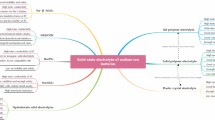Abstract
From e.m.f. measurements on the concentration cells Ag|AgCl|RbCl (m)∥RbCl (m f)|AgCl|Ag and Rb-amalgam|RbCl (m f)∥RbCl (m)Rb-amalgam, the ion and solvent transference numbers have been determined for aqueous RbCl solutions at molalities up to 7 mol kg−1 over the temperature range from 25 to 55°C. From the ionic transference numbers found, aqueous RbCl emerges as the most closely equitransferent salt bridge ever characterized. Considering also its high solubility (7.8 mol kg−1 at 25°C), RbCl is recommended as a built-in salt bridge for reference electrodes, in view of replacing the insufficiently equitransferent KCl bridges so far adopted by manufacturers.
Similar content being viewed by others
References
E. A. Guggenheim, J. Phys. Chem. 36 (1930) 1752; J. Am. Chem. Soc. 52 (1930) 1315.
A. K. Covington, in ‘Ion Selective Electrodes’, NBS Special Publication 314 (edited by R. A. Durst) Washington DC (1969), p. 107, and literature cited therein.
R. G. Bates, ‘Determination of pH — Theory and Practice’, 2nd edn, Wiley, New York (1973), pp. 311–27.
R. G. Bates, op. cit. [3]‘, pp. 54, 324.
K. Cammann, ‘Working with Ion-Selective Electrodes,’ Springer, Berlin (1979), pp. 35–42.
D. J. G. Ives and G. J. Janz, ‘Reference Electrodes — Theory and Practice’, Academic Press, New York (1961), pp. 505.
T. Mussini, J. Chem. Educ. 65 (1988) 242.
P. Longhi, F. D'Andrea, P. R. Mussini, T. Mussini and S. Rondinini, Anal. Chem. 62 (1990) 1019.
P. R. Mussini, F. D'Andrea, A. Galli, P. Longhi and S. Rondinini. J. Appl. Electrochem. 20 (1990) 651.
P. R. Mussini, S. Rondinini, A. Cipolli, R. Manenti and M. Mauretti, Ber. Bunseges. Phys. Chem. 97 (1993) 1034.
R. A. Robinson and R. H. Stokes, ‘Electrolyte Solutions,’ 2nd edn., Butterworths, London (1965), pp. 463–65.
W. J. Hamer and Yung-Chi Wu, J. Phys. Chem. Ref. Data 1 (1972) 1047.
P. Longhi, T. Mussini and C. Osimani,. J. Chem. Thermodyn. 6 (1974) 227.
P. R. Mussini, P. Longhi, T. Mussini and S. Rondinini, J. Appl. Electrochem. 20 (1990) 645.
R. H. Stokes, J. Amer. Chem. Soc. 76 (1954) 1988.
R. A. Robinson and R. H. Stokes, op. cit. [11], pp. 155–57.
T. Mussini and A. Pagella, J. Chem. Eng. Data 16 (1971) 49.
D. J. G. Ives and G. J. Janz, op. cit. [6], pp. 203–7.
W. F. Linke and A. Seidell, ‘Solubilities — Inorganic and Metal-Organic Compounds’, vol. 1, American Chemical Society, Washington DC (1958), pp. 60, 66–70.
K. R. Patil, A. D. Tripathi, G. Pathak and S. S. Katti, J. Chem. Eng. Data 36 (1991) 225.
R. A. Robinson and R. H. Stokes, op. cit. [11], p. 34.
T. Mussini, C. Massarani-Formaro and P. Andrigo, J. Electroanal. Chem. 33 (1971) 189;
T. Mussini, P. Longhi and P. Giammario, Chim. Ind. (Milan) 54 (1972) 3, 1093;
R. Cavaliere, P. Longhi, T. Mussini and S. Neglia, Gazz. Chim. Ital. 109 (1979) 495.
SAS ‘User's Guide: Statistics’, Version 5, SAS Institute, Inc., Cary, N. C. (1985) pp. 575, 655.
R. A. Robinson and R. H. Stokes, op. cit. [1l], pp. 458, 468.
Idem, op. cit. [1l], p. 554.
H. R. Stokes, J. Phys. Chem. 65 (1961) 1242.
B. M. Cook and H. R. Stokes, J. Phys. Chem. 67 (1963) 511.
R. G. Bates, op. cit. [3]‘, pp. 36–37.
A. K. Covington, R. G. Bates and R. A. Durst, Pure Appl. Chem. 57 (1985) 531.
E. A. Guggenheim, J. Amer. Chem. Soc. 52 (1930) 1315; J. Phys. Chem. 36 (1930) 1758.
A. K. Covington, in ‘Ion-Selective Electrodes’, NBS Special Publication 314, Washington DC (1969) pp. 127–29.
Author information
Authors and Affiliations
Rights and permissions
About this article
Cite this article
Buizza, C., Mussini, P.R., Mussini, T. et al. Characterization of aqueous rubidium chloride as an equitransferent ultraconcentrated salt bridge. J Appl Electrochem 26, 337–341 (1996). https://doi.org/10.1007/BF00242104
Received:
Revised:
Issue Date:
DOI: https://doi.org/10.1007/BF00242104




